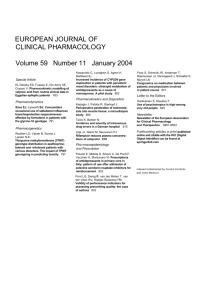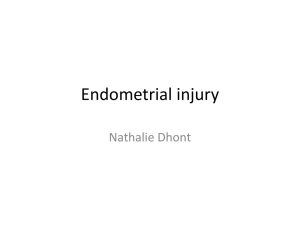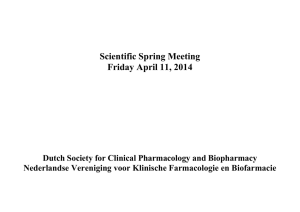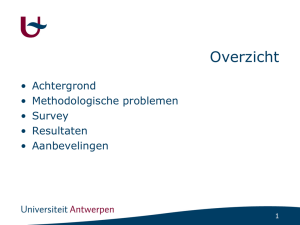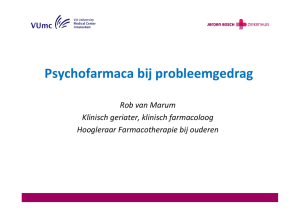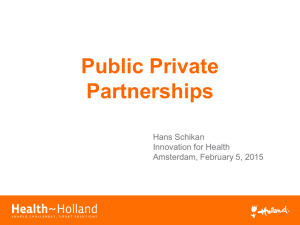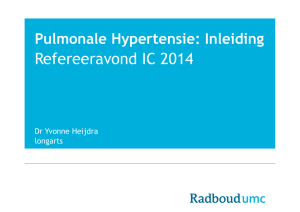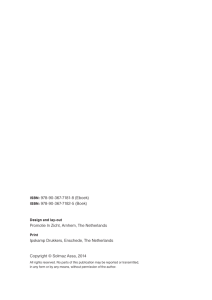Voorschrijfvoorkeuren in acute agitatie
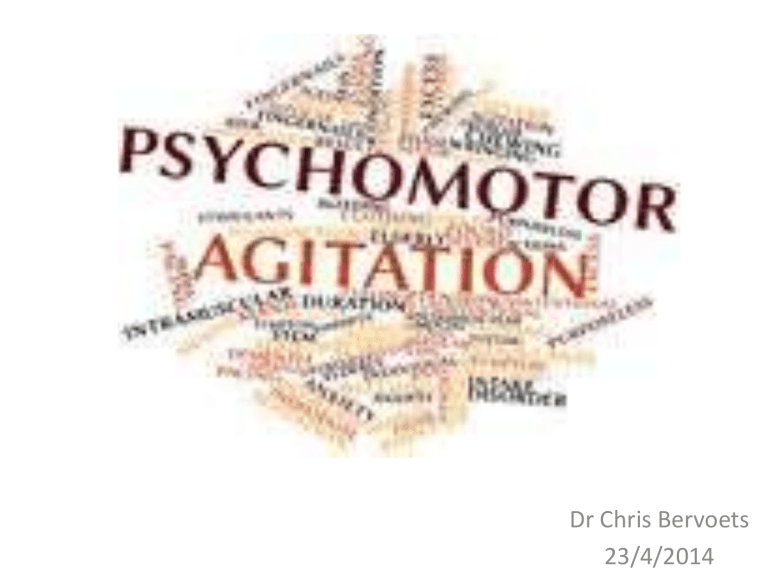
Dr Chris Bervoets
23/4/2014
De uitdaging van acute agitatie
•
Patienten”beheer” en patiëntveiligheid
•
Voorafgaand aan opname
• Nosologisch kader, tijdsverloop, prodromen,..
•
Op spoed/PAAZ/..
• Hoe ingrijpen ? Wanneer ingrijpen ? Met welk middel ingrijpen ?
• Farmacologisch : EBM ? Uitkomstmaten ? Veiligheidsaspecten?
• Non-farmacologisch : Veiligheid voor pt & personeel? Ethische aspecten ? Relatie met farmaca-gebruik ?
KLINISCH
• Overmatig motorisch en verbaal gedrag (ijsberen, prikkelbaarheid, affectieve instabiliteit, vuisten maken, deuren gooien.. )
• Echter: klinisch plaatje is amper gekend…
• Escalerend in de tijd
• Echter: longitudinaal verloop is amper gekend…
• Hoge ratio aan co-morbiditeit
• Echter: relaties met andere aandoeningen zijn niet duidelijk…
Het preventieprobleem
Agitation reduction techniques
Agitation Violence
Precipitating Events increasing agitation
Etiologie
•
Somatisch toestandsbeeld
•
Psychiatrisch toestandsbeeld
•
Affectieve stoornis
•
Psychotische stoornis
•
Persoonlijkheidsstoornis
•
Middelenmisbruik ( frequent concomitant) !
Schizophrenia
Mania
Agitated Depression
Substance intoxication or Withdrawal
Akathisia
Personality Disorder-Antisocial
Psychiatric
Medical
HOOG RISICO
Schizofrenie + middelengebruik+ compliance > Schizofrenie > Affectieve
UITLOKKENDE FACTOREN
Comorbied middelenprobleem
Wanen & hallucinaties
Impulscontrolestoornissen
Temperament (novelty seeking )
Chaotische omgeving
Citrone, L, Volavka: Violent patients in the emergency setting. Psych Clinic NA 1999;22:789-801
Delirium
Dementia
Hyperthyroidism
Head Trauma
Temporal Lobe Epilepsy
Epidemiologie (US data)
• Psychiatrische patienten (Allen 2000)
• 4.3 X 10 6 spoedgevallen bezoeken/jaar
• 5.4% van alle spoedgevallen patienten
• Gemiddeld 400 patienten/maand/EPSI (Currier 1999)
• Prevalentie van agitatie
• 1.7 x 10 6 van de spoedconsulten op jaarbasis
• 8.5% van alle EPSI-aanmeldingen noodzaken afzondering (Currier 2000)
• Gemiddelde duur van afzondering is 6 uur(Currier 2000)
• 111 dodelijke incidenten in afzondering over 10 jaar in New York (Sundram
1994)
• Geschat 50 - 150 doden per jaar tgv afzondering (Allen 2000)
Behandeling : hoe
• NIET FARMACOLOGISCH: afzondering en fixatie
• ADVIES HGR in de maak
• FARMACOLOGISCH (naast oorzakelijke pathologie ):
• BENZODIAZEPINES
• ademhalingsdepressie
• Te hoge sedatie
• Paradoxale desinhibitie
• ANTIPSYCHOTICA
• CAP
• akute dystonie
• akathisie
• Te hoge sedatie
• Maligne neuroleptisch syndroom
• AAP
• Goede tolerantie in acute fase
Behandeling : waarom ?
•
Preventie van gewelddadige incidenten
•
Beter diagnostisch proces
•
Begin van het therapeutisch proces
• Patient participatie
• Betere compliance op lange termijn
• Betere therapeutische relatie
• Binder, Rl, McNeil, DE: Contemporary practices in managing acutely violent patients in 20 psychiatric emergency rooms. Psych Services
1999;50:1553- 1554.
• Fishkind, AB: Agitation II: De-escalation of the aggressive patient and avoiding coercion.
Emergency Psychiatry, 2008.
Monitoring
• Veiligheid
• cfr discussie in media omtrent EPSI erkenningen !
• Resultaat
• Positive And Negative Syndrome Scale Excited Component
(PANSS EC)
• Agitation-Calmness Evaluation Scale (ACES)
• Corrigan Agitated Behavior Scale (CABS)
• Cohen-Mansfield Agitation Inventory (CMAI)
• Andere paradigma’s : ESM ( Holter)
GOLD STANDARD
• TREC studies : promethazine/lorazepam
• Rapid tranquillisation for agitated patients in emergency psychiatric rooms: a randomised trial of midazolam versus haloperidol plus promethazine BMJ 2003;327:708
• TREC-Rio trial: a randomised controlled trial for rapid tranquillisation for agitated patients in emergency psychiatric rooms BMC Psychiatry 2002, 2 :11
• Rapid tranquillisation of violent or agitated patients in apsychiatric emergency setting: Pragmatic randomised trial of intramuscular lorazepam v. haloperidol plus promethazine BJP 2004, 185:63-69
• Domus Medica: Haloperidol/lorazepam/promethazine
• UpToDate : droperidol/haloperidol/midazolam/lorazepam
• Toch opmerkelijk gelijklopend ondanks
• moeilijke klinische omschrijving van agitatie
• Zeer verschillende behandelsettings
Hoe doen Vlaamse urgentie-artsen en psychiaters het ?
Background
The pharmacotherapeutic management of agitated behaviour is a common clinical challenge, not only in psychiatric practice but also in emergency settings.
Current available research suggests that pharmacotherapy is frequently used, although guided by limited evidence.
Yet, notwithstanding many methodological issues in this research field, several guidelines for the treatment of agitated behaviour have been developed.
It is unclear to what extent the clinician follows these guidelines and which pharmacological strategies are being used, since prescription behaviour for agitation has hardly been investigated before.
Objective
(i) to describe the current prescribing patterns of psychiatrists in Belgium
(ii) to evaluate to which extent prescribing patterns are in accordance with evidence originating from clinical trials in the field of treatment of agitated behaviour.
Method
A cross-sectional survey in the dutch-speaking part of Belgium (Flandres)
39 psychiatric hospitals, 11 psychiatric wards of a general hospital and 61 emergency departments.
Participating psychiatrists and emergency physicians are asked to give demographic information, record their prescribing habits in the treatment of acute agitation ( irrespective of the underlying DSM-IV diagnosis), their use of evidence based guidelines and the type of monitoring ( effectiveness, safety) they provide for their patients.
The following aspects of the responses were evaluated;
(i) which medication classes and specific drugs were preferred (both mono- and polypharmaceuticalstrategies) and whether these preferences changed in case the patient needed seclusion and/or restraint.
(ii) differences in prescribing habits between different groups of doctors.
Results (1)
Response rate and respondents characteristics
110 psychiatrists and emergency doctors responded to the online survey, yielding a response rate of 20 %.
70 (63,6%) are male and 40 (36,4%) are female.
Psychiatrist accounted for 65,5 % of the answers, emergency doctors for 34,5 %.
The majority of respondents were between the age of 30 and 45 years.
Doctors worked in different settings; 43 (39,1%) in a psychiatric hospital, 25 (22,7 %) in a psychiatric ward of a general hospital and 42 (38,2
%) in an emergency service.
A caseload between 1 and 10 patients per month was reported by 71 (62,7%) of the participants, 23 (20,9%) had a monthly caseload between 10 and 20 and 16 (14,6%) reported a caseload higher than 20 patients.
Results (2)
General preferences for a medication class in acute agitation
The highest ranking medication class were antipsychotics (58,2 %).
Benzodiazepines were highest ranked as a second preference (53,6 %), followed by mood stabilizers (36,4 %) in third ranking, antidepressants (37,3 %) in fourth ranking and antihistaminics (43,6 %) in fifth ranking.
Results (3)
Prescribing preferences in non-secluded patients.
Olanzapine (21,8%), lorazepam (20,9%) and clothiapine (19,1%) were the three highest ranked drugs.
Most frequent ranked second were lorazepam (20,9%), olanzapine (17,3%) and droperidol (11,8%).
In third order, clothiapine (12,7%), lorazepam (10,9%) and olanzapine (10,9%) were reported most.
Although zuclopenthixol does not appear but in third choice (2,7%), the long acting formula of this drug is reported more frequently (1,8%;2,7%;8,2%).
Of the participants, 20,9 % reported to use one and only one drug whilst a combination of drugs is used by 10,9 %. This combination of drugs is in 65,5 % prescribed in a step-up regimen.
Results (4)
Prescribing preferences in secluded patients. prescription preferences changed when patients were in need of a seclusion room as a nonpharmacological approach to agitation in 60,9 % of the participants ( 37,3 % of participants reported not to change their prescription preferences).
Clotiapine (16,4%), droperidol (11,8%) and olanzapine (10,9%) were the three highest ranked drugs.
Most frequent ranked second were lorazepam(15,5%), clothiapine (9,1%) and diazepam (8,2%).
In third order, haloperidol (7,3%), clothiapine (6,4%) and lorazepam (6,4%) were reported most.
Again, zuclopenthixol does not appear but in third choice (1,8%). However, the long acting formula of this drug is reported more frequently than in the non secluded group of patients (4,5%;3,6%;7,3%).
Of the participants, 8,2 % reported to use only one drug ( monotherapy) whilst a combination of drugs is used by 17,3 %. Again, for 36,4 % these drugs are prescribed in a step-up regimen.
Results (5)
Between group differences
Psychiatrists vs AE-doctors ( non secluded patients)
Of the psychiatrists, 19 (26.4%) put a benzodiazepine as preferred product, whereas this was significantly higher in AE doctors group (n=18; 47.4%;
Fisher's exact test p=0.034).
27 psychiaters (37.5%) and 10 AE doctors (26.3%) used conventional neuroleptics as their product of choice (p = .291).
27 psychiatrists (37.5%) favoured an atypical antipsychotic, in contrast with only 7 (18.4%) in the other group (p=0.51).
Results (6)
Results (7)
Between group differences
Psychiatrists vs AE-doctors ( secluded patients)
Psychiatrists use benzodiazepines as treatment for agitated patients that have to be separated significantly less (n=5; 10.6%) compared to urgency doctors
(n= 9 ; 42.9%; p=0.011)
Thirty (63.8%) psychiaters preferred to use a conventional neuroleptic in this indication, which was not significantly different (p=0.101) from the other physicians (n=8; 38.1%).
12 (25.5%) psychiatrists used an atypical antipsychotic, which was similar to the urgency doctors (n=2; 9.5%; p=.271)
Results (8)
Results (9)
Effect of age ( all doctors considered); sample dichotomized (younger vs > 45Y)
(NONSEP) older MD (n=6) tended to prefer droperidol more than younger
MD (n=1) p=0.12
(NONSEP) MD preferred lorazepam (p=0.091)
(NONSEP) no effect of age for clorazepate,clotiapine, haloperidol, olanzapine or quetiapine , additionally (SEP) no effect of age for droperidol, lorazepam, zuclopenthixol
LA
Results (10)
Is a product prescribed significantly more often in separated vs non separated patients?
(Interactions Q11 & Q14 (McNemar test)
CLORAZEPAAT p = 1.000
CLOTIAPINE p = 1.000
DIAZEPAM p = 1.000
DROPERIDOL p=0.022, more often in separated patients
HALOPERIDOl .625
OLANZAPINE p = 1.000
LORAZEPAM p=0.022, more often in non separated patients
SUMMARY
Antipsychotics are most preferred, followed by benzodiazepines
Olanzapine and Lorazepam are preferred most in non-secluded (NS) patients
Clotiapine and Lorazepam are preferred most in secluded (S) patients
In NS & in S patients, AE use more benzodiazepines than psychiatrists. Both groups are similar with regard to AAP and CAP
Older MD use droperidol more often, younger MD prefer lorazepam in NS patients. There is no effect of age in S patients
If separation is considered as the intervention, analysis reveals a preference for droperidol in S patients and lorazepam in NS patients
CONCLUSION
amount of agitation is of importance in choice of drug prescription preferences are in accordance with EBM this is not the case for ZUCLOPENTHIXOL in the psychiatrist group
AE and PSY have different preferences, ib. for older vs younger effect of education and/or therapeutic goal selection ? effect of drug selection in a hospital? effect of drug company communication?
Met dank aan:
Prof Dr Morrens
Prof Dr Sabbe
Dr Chris Bervoets
Prof Dr Guido Pieters
Dr Jurgen Defruyt
Dr Koen Titeca
Dr Barry Dekeyser
